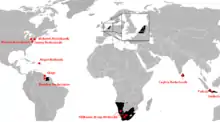
A Dutch creole is a creole language that has been substantially influenced by the Dutch language.
Most Dutch-based creoles originated in Dutch colonies in the Americas and Southeast Asia, after the 17th century expansion of Dutch maritime power. Almost all of them are now extinct, while two known varieties are classified as "critically endangered". The extinction has generally been attributed to a wilful cultural and generational language shift towards standard Dutch or the majority language of the area with each successive generation.
Afrikaans is considered to be a daughter language of Dutch[1][2] and it, by contrast, is vibrant and has completely displaced Dutch in southern Africa. Though not a majority-held position, it is considered by some linguists to be a creole because of its simpler grammar relative to Dutch.[3][4]
List
Some important Dutch creoles are the following:
| Creole | Location | Status |
|---|---|---|
| Berbice[5] | Guyana | extinct[6] |
| Skepi | Guyana | extinct[7] |
| Negerhollands[8] | U.S. Virgin Islands | extinct[8] |
| Petjo | Indonesia, immigrant community in the Netherlands | extinct or critically endangered |
| Javindo[9] | Indonesia | critically endangered[10] |
| Mohawk Dutch | United States | extinct |
| Jersey Dutch ("Negro Dutch") | United States | extinct |
Dutch has also made a significant contribution to other creoles:
- Papiamento — based mostly on Portuguese and Spanish, spoken in Aruba, Bonaire and Curaçao.
- Saramaccan — based mostly on English, Portuguese and African languages, spoken in Suriname
- Sranan Tongo — based mostly on English, spoken in Suriname
- Manado Malay — based on Malay with a significant number of Dutch vocabulary, spoken in the city of Manado, Indonesia
Despite its name, Pennsylvania Dutch is not descended from Dutch, but is a variety of West Central German.[11]
See also
References
- ↑ Pithouse, K.; Mitchell, C; Moletsane, R. Making Connections: Self-Study & Social Action. p. 91.
- ↑ Heese, J. A. (1971). Die herkoms van die Afrikaner, 1657–1867 [The origin of the Afrikaner] (in Afrikaans). Cape Town: A. A. Balkema. OCLC 1821706. OL 5361614M.
- ↑ Deumert, Ana (2017-07-12). "Creole as necessity? Creole as choice?". Language Contact in Africa and the African Diaspora in the Americas. Creole Language Library. Amsterdam: John Benjamins Publishing Company. 53: 101–122. doi:10.1075/cll.53.05due. ISBN 978-90-272-5277-7. Retrieved 2021-08-03.
- ↑ Smith, J.J (1952). "Theories About the Origin of Afrikaans" (PDF). Hofmeyer Foundation Lectures, University of the Witwatersrand. Archived (PDF) from the original on 2022-10-09.
- ↑ Kouwenberg, Silvia (1994). A Grammar of Berbice Dutch Creole. Walter de Gruyter. ISBN 978-3-11-013736-1.
- ↑ "Berbice Dutch officially extinct". Radio Netherlands Worldwide. February 25, 2010. Archived from the original on August 7, 2017. Retrieved May 17, 2022.
- ↑ Buckley, James; Stremme, Robert (2003). Scholastic Book of Lists. Scholastic Reference.
- 1 2 van Rossem, C.; van der Voort, H. (1996). Die Creol Taal: 250 Years of Negerhollands Texts. Amsterdam: Amsterdam University Press – via Digitale Bibliotheek voor de Nederlandse Letteren.
- ↑ Willems, Wim (1994). Sporen van een Indisch verleden (1600–1942). Leiden: COMT. pp. 140–143. ISBN 90-71042-44-8.
- ↑ UNESCO Atlas of the World's Languages in Danger
- ↑ Buffington, Alfred F.; Preston A. Barba (1965) [1954]. A Pennsylvania German Grammar (Revised ed.). Allentown, PA, USA: Schlecter's. pp. 137–145.